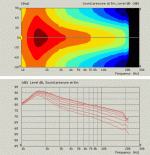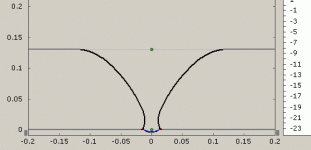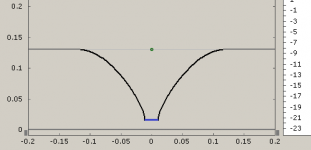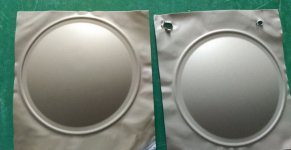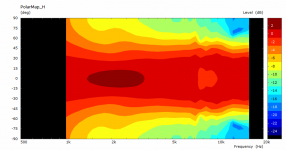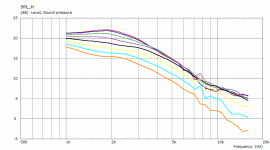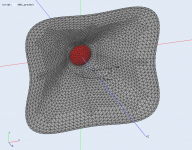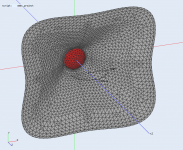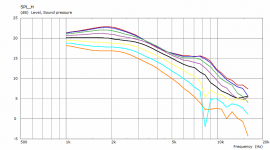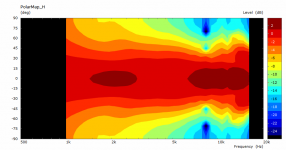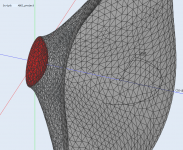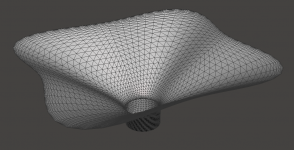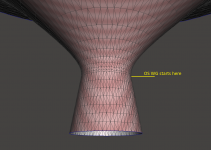I don't get what you're aiming at. Once you get a spherical wave, it's radius should not be crucial - it's only expanding. You can do it on a 1.75" or 3" diaphragm, that shouldn't really matter (suspecting smaller diaphragms to behave better, as usual).
sorry for bad explanation
Attachments
No, I have not. There should be a phase plug on the left half of it, and that's what we already have. The moving diaphragm is not a spherical wave so the situation is not symmetrical.
Last edited:
That would indicate that a hard diaphragm dome tweeter, if accurately fitted, could work pretty well in a simple conical waveguide.
2 prototype domes of slightly different composites.
Attachments
The point here is that a conical waveguide seems better suited for a dome tweeter than an OS waveguide - I tried some, those weren't that nice, I just didn't show that. I will release the new (much updated) version soon so everyone can test whatever combination.
Whether a specific waveguide works with a specific dome tweeter depends on the shape, construction and materials used, both of the dome, suspension and (integration of the) voice-coil.
Last edited:
Of course, I'm talking about the first (ideal) approximations here.
It really surprises me - this is a 44 mm (!) dome piston in a conical throat - not bad at all. Pretty wide constant directivity, isn't it.
It really surprises me - this is a 44 mm (!) dome piston in a conical throat - not bad at all. Pretty wide constant directivity, isn't it.
Attachments
There is a protection grid though...which could be removed with some heat according to some people.
Also, it's a 34 mm diameter and you have 2 version for the dome to choose from
Also, it's a 34 mm diameter and you have 2 version for the dome to choose from
The same for OS throat.
In the Appendix of my book, I did an analysis of an axially vibrating source at the throat of a cone. In that solution, I predicated that as long as only the lowest mode propagates the source curvature doesn't matter much. BUT, as the second mode comes in things get much more complicated, usually a widening. In the 1" case this would be around 7-8 kHz. Seems confirmed by your analysis.
Throat conical extension - beta 5
I've always wanted to know what happens for a conical throat extension. Now you can try it yourself:
ThroatExtension = 20 ; [mm] (default = 0)
Download link: ath-4.4.3-beta-5.zip
This isn't working for me. When I select this option, with any length greater than zero it yields a waveguide that's a cylinder.
I am using supershapes, not sure if that's part of the problem.
Please upload the config file to let me check.This isn't working for me. When I select this option, with any length greater than zero it yields a waveguide that's a cylinder.
It works for me for whatever I try -
Attachments
Last edited:
Interesting! By using a non-zero value for "ThroatAngle", I got a working waveguide.
Earlier today, when using a value of zero, I wasn't getting a functional waveguide.
Here's where things get confusing:
When using a throat angle of zero, it now works. But it didn't work earlier.
I'm guessing that the wall angle that I was using earlier may have been at the edge of what can work. We see that certain extreme wall angles will cause the program to go into a loop.
Or at least, that's my best guess.
Nonetheless, everything is working now.
Earlier today, when using a value of zero, I wasn't getting a functional waveguide.
Here's where things get confusing:
When using a throat angle of zero, it now works. But it didn't work earlier.
I'm guessing that the wall angle that I was using earlier may have been at the edge of what can work. We see that certain extreme wall angles will cause the program to go into a loop.
Or at least, that's my best guess.
Nonetheless, everything is working now.
If you're in the mood to post documentation, could you tell us how to simulate a diaphragm that's not flat?
You've posted sims over the past week using dome tweeters, but none of us know how to sim them.
No rush, I know it's the weekend, but if you have a CFG file you could post, we'll figure it out.
You've posted sims over the past week using dome tweeters, but none of us know how to sim them.
No rush, I know it's the weekend, but if you have a CFG file you could post, we'll figure it out.
- Home
- Loudspeakers
- Multi-Way
- Acoustic Horn Design – The Easy Way (Ath4)

